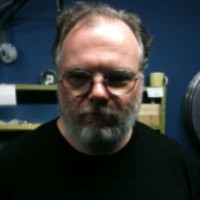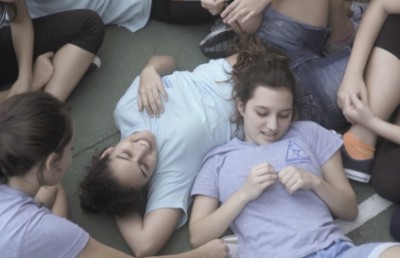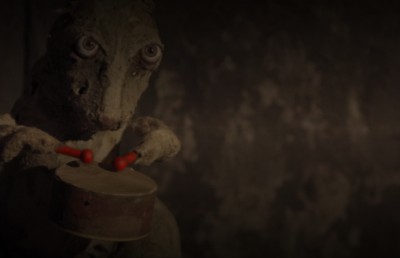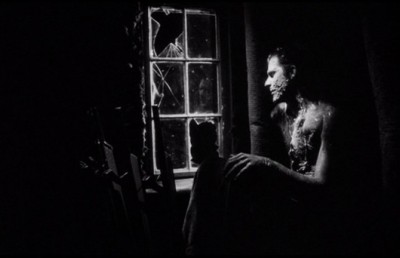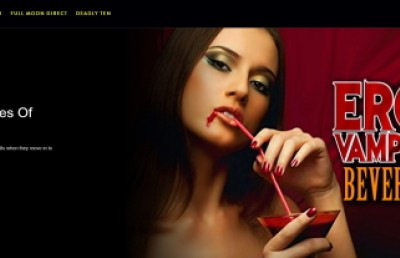A Conversation with Independent Filmmaker Michael Glover Smith
_in_the_bar_1000_418_90_c1.jpg)
Michael Glover Smith is a Chicago-based writer-director, author, critic, and lecturer who has been described on RogerEbert.com as “one of the Windy City’s finest filmmakers.” He was born and raised in Charlotte, North Carolina, graduated from Chicago’s Columbia College in 2000, and earned an MA in Film Production from Humboldt State University in California in 2004. He has directed a series of short films, two of which, At Last, Okemah! (2009) and The Catastrophe (2011), won awards on the festival circuit. Since 2009, he has taught courses on film history and aesthetics at five different Chicago-area colleges: Oakton Community College, Triton College, Harold Washington College, Harper College, and the College of Lake County. He is the author of the blog White City Cinema and his book about the silent film industry in Chicago, Flickering Empire, was published by Columbia University Press in 2015. He has directed three independent features: Cool Apocalypse (2015), Mercury in Retrograde (2017), featuring French actress Roxane Mesquida, and Rendezvous in Chicago (2018). His films are notable for their mix of dry wit, visual stylishness, and ultimately serious reflections on contemporary relationships. This interview was conducted by e-mail May 5-9, 2020, with an update on July 18, 2021.
_630_263_90.jpg)
Mercury in Retrograde (2017)
Offscreen: Your films all revolve around relationships, each film juxtaposing couples at different stages of their relationships. You also prefer to tell your stories over limited time spans (a day, a weekend, almost in real time). Why do you like this narrative structure? Why is this theme so interesting for you?
Michael G. Smith: I wrote seven feature-length screenplays before I wrote Cool Apocalypse, my first feature, in 2014. That’s one of the reasons I’ve sort of been a late bloomer as a filmmaker. Those early scripts, none of which I’ll ever direct, were all way more plot-driven and genre-oriented than anything I’ve written since. I was basically using the process of writing to teach myself how to write and it took me a while to realize that it wasn’t organic for me to write that kind of film. I was trying too hard to come up with complex and elaborate plots that I thought would be original and clever, but I had to kind of gut-wrench them out. When I wrote Cool Apocalypse, I basically said, “Fuck it. I just want to make a feature before I’m 40 years old. What kind of movie can I write that I can shoot for $5,000?” The answer I came up with: Write about just a few people interacting with each other primarily in a single location. I knew I could do that cheaply if I shot most of it in my own apartment. So I meditated on that for a while and eventually the idea came to me to examine two couples at opposite ends of the relationship spectrum: One couple going on their first date vs. another on-again/off-again couple breaking up for the final time. I figured two of those characters could be roommates and that would be a good excuse to bring everyone together for a climactic dinner scene. As soon as I knew that would be the overarching structure, the words just started flowing out like water from a faucet. So dealing with this subject matter (relationships, communication, etc.) started out as a practical way for me to make a movie for no money, but I soon realized that it also just felt more natural for me to make films that are more character-driven and more like proverbial slices of life.
Offscreen: Would you agree that Chicago is a major character in your films? Can you talk about the ways the city shapes your narratives and characters?
MGS: I always think about locations, exterior as well as interior, when writing. I can’t write a scene unless I can visualize where it’s taking place – even if I don’t actually end up shooting there. I’ve lived in Chicago since 1993, in many different neighborhoods, so it’s a city I know very well. It has a unique character. It’s a major metropolis, but it’s also in the heart of the Midwest – surrounded by farm country – and I think it’s a bit friendlier, more laid-back and unpretentious than, say, New York or L.A. If I’m writing about a neighbourhood, I always try to create characters and narratives that will seem authentic to those particular spaces. For instance, Rogers Park, where the “Cats and Dogs” segment of Rendezvous in Chicago takes place, has an extremely diverse population in terms of race, nationality and sexual identity. It has a long history of progressive activism and Obama actually kicked off his Senate campaign there in 2004 at a restaurant called the Heartland Café. So it made sense to me, and it would make sense to anyone who knows the neighborhood, that the main characters in that vignette would be an interracial gay couple.
Offscreen: Your description of your filmmaking process has many directorial decisions being made at the writing stage. Is it crucial that you write your own scripts? Can you even see yourself directing somebody else’s screenplay?
MGS: I think of directing and writing as interrelated and it’s difficult for me to imagine directing a film based on someone else’s screenplay. However, I would certainly welcome the challenge if someone were to make me an offer.
Offscreen: What effect does the detailed depiction of specific neighbourhoods, as opposed to shots of famous landmarks that are usually used to indicate location, have? Another way to phrase this is to ask you to expand on your distinction between “real Chicago movies” and “tourist movies.”
MGS: I almost always hate it when Chicago movies contain shots of famous landmarks – especially if they’re part of a perfunctory montage designed to impart an “urban” flavour in between interior dialogue scenes. For a long time you’d see the Wrigley Building, the Sears Tower, and the Art Institute in Chicago movies. But the new big cliché is for filmmakers to show Anish Kapoor’s Cloud Gate sculpture (more colloquially known as “the Bean”). The truth is that Chicago is full of residential neighbourhoods that are spread out over a large geographical area. Most Chicagoans don’t live or work downtown. Most of us don’t ever see those landmarks unless we have family or friends visiting from out of town. This is why you don’t see any skyscrapers in Cool Apocalypse or Rendezvous in Chicago. You do see a shot of the Chicago skyline at the beginning of Mercury in Retrograde, which I thought was important. Most of that film takes place in rural Michigan, but since the characters were from Chicago, I wanted to emphasize exactly where they were coming from and what they were leaving behind.
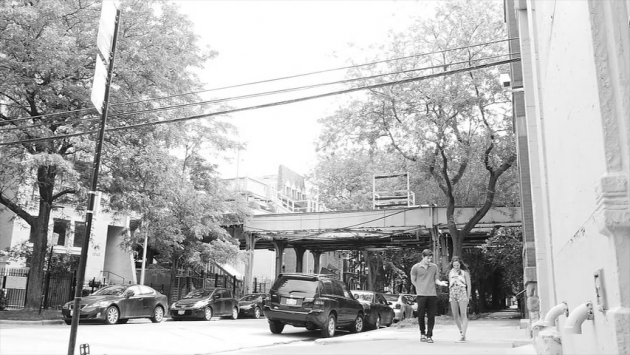
Cool Apocalypse: Julie and Paul are figures in a Chicago neighbourhood landscape
Offscreen: What are the benefits and difficulties that come with being an independent filmmaker in Chicago, as opposed to New York or Los Angeles?
MGS: The industry here is smaller, which is both a blessing and a curse. Everyone knows everyone else and the scene is, on the whole, pretty welcoming and inclusive. By contrast, in New York and, especially, L.A., it’s possible to live and work there for years without getting to know many people outside of maybe your own small circle. The disadvantage of being an indie filmmaker in Chicago is that all of the bigger indie distributors are on the East and West coasts. If you make a film here, you’re going to have to turn around and try to sell it to people who are very far away. A lot of these distributors consider Chicagoans to be “regional filmmakers” and don’t really appreciate or understand the commercial appeal of what we’re doing. Fortunately, there’s a new company in Chicago, Cow Lamp Films, that specializes in putting out Midwestern films. They’re distributing Rendezvous in Chicago and they’re doing a bang-up job.
Offscreen: Does your background as film student and film lecturer influence how you make your films and what your films are about?
MGS: I think so. Every filmmaker has a sense of what “film language” is that’s informed by everything they’ve ever watched. I don’t think about it all that much when I’m shooting, but I know that most of the films I watch, inside and outside of the classroom, were made in the first half of the 20th century. It feels natural for me to shoot and cut movies a certain way, but I can tell that it sometimes confuses my collaborators, especially the younger ones, when they don’t really share my frame of reference. They want to know why I’m doing something in a way that seems strange to them when, to me, it’s as natural as breathing. For example, it’s common for me to shoot entire scenes without getting any “coverage.”
Offscreen: You have an obvious debt to Eric Rohmer. Can you talk about that? Are there other filmmakers who have influenced you?
MGS: The main thing I love about Rohmer is his specificity – geographically, culturally and meteorologically! I’ve heard people say that his films aren’t “cinematic,” that they’re just about people talking and that he should have become a novelist or a playwright instead of a filmmaker. But I think these people have a very limited understanding of what cinema is because I think Rohmer’s films are the most exquisitely cinematic of all, albeit in subtle ways. His films aren’t just about people talking. They’re about people talking in a very specific time and place. No one captured the feeling of being at the beach as well as Rohmer did in Pauline à la plage (1983), Le rayon vert (1986) and Conte d’été (1996). No one captured the colour of summer sunlight as well as Rohmer and Néstor Almendros did in La collectionneuse (1967). And the austere, black-and-white cinematography of Ma nuit chez Maud (1969) couldn’t be more perfect in rendering what it’s like to feel the cold and snow on Christmas Eve.
Offscreen: An obvious similarity to Rohmer is the shared class and educational background of your characters, who often discuss, or at least reference, specific literary works not only to illuminate character, but also to drive the narrative. Is there any common denominator to the blizzard of literary references that run through your films?
MGS: I get asked about this a lot, but the truth is I never really think about making literary references when writing. I happen to be a bibliophile and my wife is a librarian – but if any references crop up, it’s just because it feels natural for me to drop them in. While some of the characters are definitely cultured and educated (for example, Jack in Mercury in Retrograde quotes Plato and Nietzsche), others are definitely not. Wyatt in Mercury, for instance, can’t even be bothered to read The Glass Key for his book club. He’s just in it for the cigars and whiskey.
Offscreen: You have used the actor Kevin Wehby in all three of your feature films, and have used other actors (Nina Ganet, Shane Simmons, Chelsea David) more than once. What are the advantages and disadvantages of doing this? Do you create your characters with specific actors in mind? What does the individual actor bring to a project? Has a character changed during the rehearsal and filming process because of the actor’s input?
MGS: There is no downside to using the same actor more than once. In fact, it gets easier every time: The second time around they know better what to expect from you and how you run your sets as a director; and likewise, your sense of what they’re capable of as actors expands the better you get to know them. Rendezvous in Chicago was the first time I wrote parts expressly for actors I knew and it made the process a lot easier. I could hear the voices of Kevin Wehby, Clare Cooney, Nina Ganet, and Shane Simmons in my mind as I was writing their dialogue and it made the process feel almost automatic at times.
Offscreen: The question of performance seems to surface in all of your films. In Cool Apocalypse, Claudio stages a situation where he can kiss Tess, while in Mercury in Retrograde, both the book club meeting and the women in the bar reciting poetry to each other have elements of performance, and Rendezvous in Chicago has the final direct-to-camera monologue. Do you see a common thread here, or am I overthinking things?
MGS: No, this is a great question. You also could have mentioned that Julie sings and dances at the end of both Cool Apocalypse and Rendezvous in Chicago. And I think there is a definite performative aspect to the “Strip Literary Trivia” game at the beginning of Rendezvous. As far as why, I don’t know what to say except that I believe that to exist is to perform. As Shakespeare famously said in As You Like It, “All the world’s a stage, And all the men and women merely players.”
Offscreen: Cool Apocalypse was shot in a 1.78:1 ratio, Mercury in Retrograde in 2.35:1 and Rendezvous in Chicago in 1.37:1. What are the advantages and disadvantages of these different ratios?
MGS: I didn’t put too much thought into the ratio of Cool Apocalypse beyond thinking of 1.78:1 as the “new normal” (i.e., the ratio of today’s HD television screens). With Mercury, I was insistent on 2.35:1 from the beginning because I knew there were going to be important scenes involving six characters onscreen at the same time. I always saw it as a “CinemaScope” movie from the point of conception. With Rendezvous, part of the appeal of shooting in the 1.37:1 ratio was simply the fact that I hadn’t done it before; but I also knew Rendezvous was going to be a small movie and I wanted to emphasize that smallness by reducing the amount of visual information typically available to a movie viewer. In fact, I told my DP, Alex Halstead, that I wanted the experience of watching Rendezvous to feel like flipping through a sketchbook of pencil drawings.
Cool Apocalypse
Offscreen: My strongest first impression of Cool Apocalypse was that Nina Ganet gives what in a just world would be a star-making performance. What is her background? How did you find her? She plays a more aggressive female character than you will often find in a Hollywood romantic comedy. Was this your intention from the beginning, or did it change after she was cast? She also plays well against Kevin Wehby. Did you get to rehearse much before shooting? Was any of their dialogue improvised?
MGS: Nina is the best. Her audition for Cool Apocalypse was spellbinding. She was only 22 years old at the time and hadn’t yet graduated from college when I cast her. A week later, Stephen Cone cast her in his great Chicago film Henry Gamble’s Birthday Party (2015). I actually had to move some dates around to accommodate her schedule so that she could shoot both of our movies at the same time that summer. The character of Julie was always meant to be super-assertive. That was partly inspired by my wife. The scene where Julie introduces herself to Paul at the bookstore is fairly closely based on how my wife introduced herself to me. We had two days of auditions and two days of callbacks where different combinations of Pauls and Claudios could read with different combinations of Tesses and Julies. The chemistry between Nina and Kevin seemed magical to me. After the film was cast, we also had a couple days of rehearsal with all four actors before we shot, which is where we did most of the hard work. I prefer it when the shooting goes fast. I don’t want to still be figuring out character stuff when the crew is around. Having said that, there is one scene in Cool Apocalypse that did involve improvisation: The dialogue between Julie and Tess about chocolate-covered cherries on the back porch. That happened late in the shooting and we all felt very comfortable with each other. I remember saying, “Just say whatever you want” and those two women proceeded to crack me up.
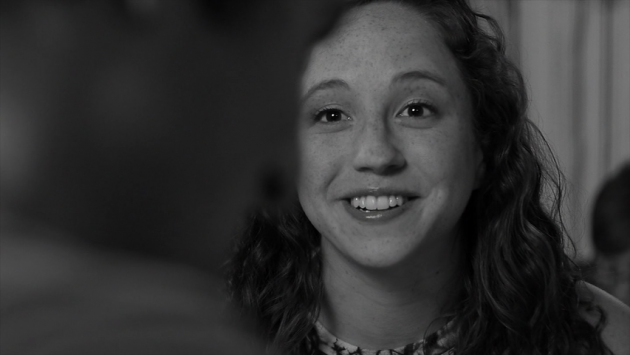
Cool Apocalypse: Nina Ganet as Julie
Offscreen: For most of the film, the camera is static. You seem to look for interesting compositions for the cast to interact and move around in rather than moving the camera itself. Was this a result of shooting on a low budget, or did you see other advantages? There are some scenes with handheld shots where the camera does move. Were you just filming each scene in the way that seemed the most effective, or was there a plan behind this?
MGS: I had a very detailed shot list and we stuck to it for the most part. In it, I described the distance between the camera and the subject and whether there would be camera movement or if the shot would be static. In the few times we did move the camera, it was handheld every time except for once. The exception was the shot where Paul and Julie kiss for the first time. She moves her chair closer to his so it was necessary for us to move the camera in order to reframe the shot. We did this, incidentally, by putting paper towels underneath the legs of the camera tripod and just sliding the whole thing across the hardwood floor. It wasn’t a bad no-budget solution for executing a “tracking shot” – although it was a relief to have a higher budget for Mercury and be able to lay actual dolly tracks on the set for that.
Offscreen: What drove your musical choices in this film?
MGS: The song “Lake Shore Drive” by [the rock group] Aliotta Haynes Jeremiah was written into the script before I had permission to use it. That was stupid of me. A lot of people outside of Chicago don’t know it, but it’s a bona fide classic rock radio staple in the state of Illinois. Anyway, I’ve always loved that song, which is obviously a great driving song, and the whole Lake Shore Drive scene wouldn’t have worked without it. I tracked down the author of the song, Skip Haynes (who also owned the master recording), and he let me have it for virtually nothing. I was very lucky. He died a couple of years later and I dedicated Rendezvous in Chicago to him. Most of the other musical selections were based on me just taking a wide variety of public domain recordings and other songs I had the rights to and trying to match them to different scenes until I found a marriage of image and sound that I thought felt right. There is also a very good and very quiet original core written by Grant Winship and Andy Roush. It’s basically a combination of gently plucked acoustic guitar and a very subtle keyboard.
Offscreen: There is a similarity between the scenes where Paul describes his novel at length in this film and the long sequence where Peggy reads out a series of horoscopes at the beginning of Mercury in Retrograde. That is, what they are actually saying isn’t that important (even if the horoscopes turn out to be accurate!); Paul is telling Julie what kind of guy he is, Peggy is trying (possibly “too hard”, as Isabelle observes) to create a place for herself in the group.
MGS: Yeah, you’re right. In both instances, the specifics of what’s being said aren’t important. It’s all about the body language and the subtext. I vividly remember shooting that scene in the diner for Cool Apocalypse. Kevin was taking a lot of time with his words. We did a few takes and he was getting slower and slower every time and his energy was going down with each take. Which is understandable, because he had to say a lot of words! So I eventually had to say to him, “Kevin, don’t think about the words you’re saying. Don’t think about the plot of this novel. The point is that you’re trying to charm her. You’re auditioning to be her boyfriend. Now look into her eyes and get your energy up!” After I said that, he poured a large amount of sugar into his hand from a container on the counter and swallowed it in one big gulp. We did one take after that and he nailed it and that’s what’s in the movie. I used to joke later on that I wasn’t Fassbinder and couldn’t afford to give him cocaine.
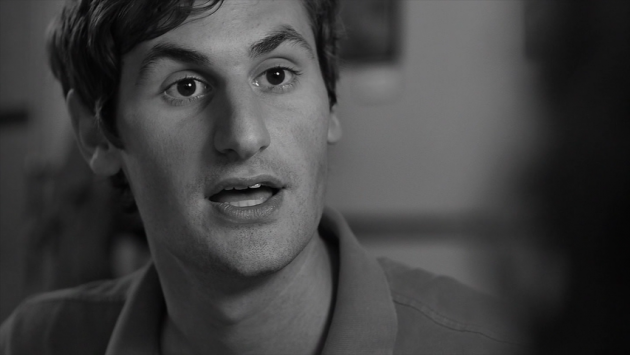
Cool Apocalypse: Kevin Wehby on sugar
Offscreen: The scene where Tess shaves her head is very powerful. How did you come up with this scene? Do you see parallels between this scene, Peggy’s relating of her past to Golda in Mercury in Retrograde, and the final monologue in Rendezvous in Chicago?
MGS: When I was in high school, a girl broke up with me and I shaved my head immediately afterwards. I thought that would be a fitting way to mark the beginning of a new chapter in my life. Like a Buddhist monk entering a monastery or something. So that part was there from the beginning but it wasn’t always so late in the film. In the earliest drafts, Tess actually shaved her head in the middle of the going-away party when Julie was still there and Paul was still awake. I originally had Tess coming out of the bathroom with a bald head and everyone sitting at the dining-room table being shocked and talking about her new haircut. My producer, Clare Kosinski, in her infinite wisdom, told me, “She should do this later on, after everyone is asleep. It should be a more private and personal thing.” I think the simple change of moving that moment to later in the evening improved the script 100%. As far as any similarities between this and the end of Mercury in Retrograde are concerned, I never thought about it. They were always very different stories in my mind. But I did recently realize that all three of my films have a climactic scene in which a woman recites a long monologue – so there must be something I like about ending a film that way.
Mercury in Retrograde
Offscreen: Your films have very different visual styles. Do you have a specific idea of how you want the film to look when you’re writing the script, or does this come in collaboration with the cinematographer?
MGS: The idea for the visual style is present at the writing stage. I knew Cool Apocalypse was going to be shot in black-and-white and consist of a lot of static shots when I was writing it. I knew Mercury was going to have a lot of camera movement and a lot of long takes. After the script is written, I do a first pass of the shot list by myself. This, for me, is the most difficult part of making a movie. It’s even more difficult than writing the script. Because I have to decide at this stage what every single moment in the movie is going to look like. And in a scene where multiple people are talking, it’s just a nightmare to contemplate. At which point do we see which characters? When do we see close-ups? When do we see a two-shot? When do we see everyone in a master? You want your shot selections to be meaningful but it’s never as simple as “Cut on the dialogue and just show the person who’s speaking.” Sometimes it’s obviously better to show the person who’s listening. Anyway, after I have the first-pass shot list, I show it to the DP and they go over it and come back to me with their suggestions, many of which I end up incorporating.
Offscreen: Following up on that question, why is the floating camera so prominent in Mercury in Retrograde (for example, in the horoscope scene), as opposed to the dominant static camera in Cool Apocalypse?
MGS: The short answer is that we had a higher budget and could afford to rent circular dolly tracks. But I also knew that the characters in this scene were going to be sitting in a circle around a fire-pit and I knew we were going to be shooting in the 2.35:1 ratio. I wanted the viewer’s eye to be able to move across the frame from one character’s face to another and I didn’t want to cut. I wanted the viewer to be able to kind of pick and choose whose face they would be watching. So it seemed like a logical place for a tracking shot. Several people at Q&As have remarked that the camera seems to be circling around the characters as if it were the planet Mercury orbiting the sun – because Peggy, at this moment, is actually talking about Mercury being in retrograde. That wasn’t a conscious intention on my part but I do think it’s a fantastic and valid way to look at the scene.
Offscreen: Mercury in Retrograde feels much more novelistic than Cool Apocalypse or Rendezvous in Chicago. That is, while you still have a small cast, much of the action set in a single space and a limited time (except it’s a weekend instead of 24 hours), the breadth and depth of characters seems much broader. Do you agree?
MGS: Yes, I spent more time writing the script for Mercury than anything else I’ve ever written. I wrote ten drafts over a span of 14 months and I was always conscious of trying to create something that would be a multilayered experience for the viewer. The plan from the beginning was to go deep and dark with these characters and their situations but to do it in a sneaky way, so that the extent of the darkness wouldn’t be apparent to the viewer until the very end. It always makes me happy when people tell me that they’ve watched the film again and got more out of it the second time.
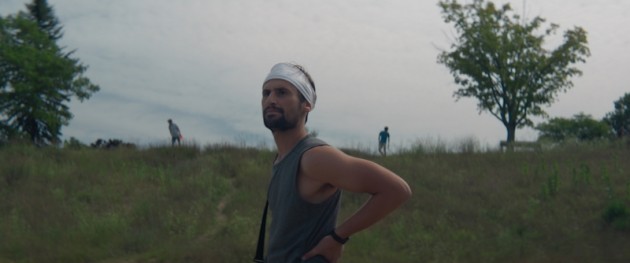
Mercury in Retrograde: The disc golf game
Offscreen: This is your best looking film, lacking the occasional roughness of the other two. Is this only a question of budget, or am I right in thinking it’s deliberate? What are the advantages of what I might call visual polish, as well as those of intentional imperfection?
MGS: This is a tricky question. The budget is definitely a factor but, because I always have a good idea of what my budget will be pretty far in advance, I’m also usually tailoring the style of the film to the budget when writing. We shot Rendezvous in Chicago for $20,000, which is crazy low, especially considering we had to rent the camera and all of our gear and we paid all of the actors SAG wages. We didn’t really skimp on anything. We just shot it very fast – in 8 days to be exact. But that was also all of the time that we needed because I wrote the film specifically so that we could shoot it that way. If someone had given me $100,000 at the time and said, “Hey, I want you to make this same movie but here’s more money so you can make it look more beautiful,” I wouldn’t have agreed to do that. I probably would have said, “Thank you for believing in me, but let me write another film for which that budget would be more appropriate.” And then I would have made another movie entirely.
It was definitely fun to execute the elaborate tracking shots in Mercury. It’s fun to make things look polished and beautiful. But it’s not always necessary. Unfortunately, cinematographers always want everything to look perfect because that’s the way they’re trained. They’re afraid it will reflect poorly on them if they do anything less than that. Before we made Rendezvous, I showed my DP the first section of Rohmer’s Rendezvous in Paris (1995), which was shot on 16mm and features handheld shots of actors walking down the street that are surprisingly shaky – because Rohmer made that film quickly and clandestinely. I said to my DP, “Notice how shaky these handheld shots are? It’s okay for the ‘Cats and Dogs’ segment of our film to look like this when the actors are walking down the street.”
Offscreen: Would you agree that this is as much a Chicago film as the other two? If so, can you talk about what makes it one?
MGS: I think so. These characters, with the obvious exception of Isabelle (who’s French), have lived in Chicago for a very long time. Jack and Golda talk about having met at DePaul University over a decade ago and the film is studded with other references to Chicago throughout (for example, the inferiority of the farmers’ market vegetables in Chicago). So I think it’s about Chicago in a cultural sense – in the same way that I think Ethan Hawke’s character, Jesse, represents “Texas” in Linklater’s Before films, even though they were all shot in Europe.
Offscreen: There are any number of classic (and not so classic) films that transplant urban characters into a country setting. Did you have any films in mind when you were making Mercury in Retrograde?
MGS: F.W. Murnau’s City Girl (1930) is about moving from the city to the country and that was certainly a big influence. The early scenes in that film, which are set in Chicago, are a great depiction of urban loneliness. Mary Duncan’s character lives in an apartment where the “L” train goes right by her window. She has a single lonely plant that she waters on the windowsill and she also keeps a fake bird in a cage as a pet. I told Roxane Mesquida to watch that film for Duncan’s performance, and Roxane, who’s a true cinephile, told me she thought it was a masterpiece. When she got to the set, she loved that we had put a fake bird in a cage in her character’s apartment. Another big influence was Roberto Rossellini’s Journey to Italy (1954). That, to my mind, is the ultimate statement about a couple going on vacation and finally having to confront each other face-to-face because they can no longer just sweep their problems under the rug like they were doing back home. Ingrid Bergman and George Sanders are beyond great in that. Finally, I think Harold Ramis’ National Lampoon’s Vacation (1983) is an excellent dark comedy about the weird pressure you feel to show other people a good time when vacationing together. It can be hard to have fun when you feel like it’s something you’re obligated to do.
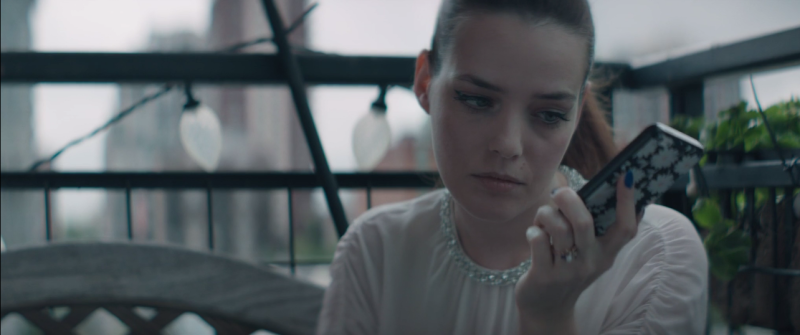
Mercury in Retrograde: Isabelle in Chicago
Offscreen: Did you have your main location before you wrote your screenplay? Or do you write it first and then look for suitable locations? How does the geography of the locations shape your stories (if they do)? How did you find the country cottage?
MGS: I originally wrote Mercury so that it would take place in a log cabin in the mountains of western North Carolina because I’m from that part of the country. But I realized pretty early on that it would be much cheaper and easier for us to shoot within driving distance of Chicago – so I had the next draft take place at a lakeside cabin in southwestern Michigan. I had been to that part of the country and thought it was very scenic and beautiful. But I had to find a specific location that would be exactly right for our purposes, so I looked at literally hundreds of cabins on a website that features “vacation rentals by owner” until I found Fern Hollow, which is the name of that charmingly antiquated cabin in Allegan, Michigan, where we ended up shooting. It was so perfect that we barely needed to do any art direction.
Offscreen: The disc golf game and book club meetings are much more loosely filmed than the scenes with the women in the café and bar. Can you talk about why?
MGS: I wanted to have moments where the viewer would be provoked into thinking about the male characters and how they relate to each other in contrast to the female characters and how they relate to each other. I thought it would be worthwhile to do this through juxtaposing physical activities during the day (disc golf vs. yoga) and intellectual activities at night (book club discussion vs. poetry recital). The cinematography articulates what’s happening with these characters in visual terms. When we shot the book club scene, I told the DP to swing the camera around wildly and not worry about the shots going out of focus. I told him that because the characters are drunk, it should feel like the movie is drunk too. This is in marked contrast to the stability of the shots of the women in the bar – although we did something interesting there too: The color red has been suppressed throughout the entire film. The only time you really see it is in relation to Peggy (her hair, some of her clothes, a flower she’s holding, the maroon chair she’s sitting in at the beginning). Then, when we get to the bar scene, the lighting that floods the bar is blood red. I told the DP that I wanted the color of the lighting to feel as if a wound had been ripped open and the film itself was bleeding.
_in_the_bar_1_630_263_90.jpg)
Mercury in Retrograde: Alana Arenas (Golda) in the bar
Offscreen: My favourite line in the film, particularly as delivered by Roxane Mesquida, is “It’s supposed to be more exciting because I’m in Michigan?”
MGS: This line, I’m happy to say, always gets a big laugh when the film plays to an audience. Richard is an idiot. The sex was obviously better for him than it was for her, so it’s almost as if he’s trying to retroactively convince her that she enjoyed it because they just did it in a place that’s exotic and unfamiliar, which makes no sense! Roxane, who is a total pro, knew exactly how to deadpan that line.
Offscreen: In a film featuring three couples, do you agree that the sexiest scene is when Isabelle does Peggy’s makeup?
MGS: Oh, I don’t know about “sexy,” but it’s maybe the most intimate moment in the film. The trajectory of Peggy’s character is that she had planned on opening up to Wyatt about her past over the weekend, hoping they could take their relationship to the next level, but it doesn’t happen that way because he’s not receptive enough to her. So she ends up connecting more with Golda and Isabelle. The big bonding scene between Peggy and Golda happens at the bar, obviously, but I thought it would also be nice for Isabelle and Peggy to have their own little bonding moment beforehand. Roxane and Najarra Townsend became very close friends during the shoot and I think that’s reflected in this moment.
_630_264_90.jpg)
Mercury in Retrograde: Roxane Mesquida (Isabelle)
Offscreen: Getting an actress as famous as Roxane Mesquida is quite a coup for an independent filmmaker. How did she become involved?
MGS: I had been a fan of hers for a long time. Fat Girl (À ma soeur) (2001, Catherine Breillat) is one of my favourite films. I show it in my Global Cinema class. I happened to see her in Philippe Grandrieux’s Malgré la nuit (2015) when I was in pre-production on Mercury, and it occurred to me while watching it that she was exactly what I needed for Isabelle (who, incidentally, was not originally written to be French). I sent the script to her agent and said I thought Roxane would be perfect for the part and she wrote me back a few days later saying that she wanted to Skype with me about it. After reading the script, she told me she thought that the character was very similar to her own personality (blunt and un-PC) and yet she had never really played that kind of role in a movie before. I am indebted to her forever for agreeing to do it because I think it’s the lowest-budget film she’s ever done.
Offscreen: Good as she was, I thought the finest performance was by Jack C. Newell as Jack. Looking him up on IMDB, he seems to be primarily a director rather than an actor. How did he get involved in the film? Did you have him in mind when you wrote the screenplay? Did he in any way shape his character? Does an actor with directing (or writing) experience bring something to performing a role that those with “only” acting experience don’t?
MGS: Jack is a brilliant actor but he was actually the last actor we cast in the film. I kept telling my casting director that I wanted a “Jimmy Stewart type” for the role of Jack, by which I meant someone who seemed like a nice guy, and she kept sending me all of these tall, lanky actors. Some of them were good, but none of them were exactly right. Eventually, she started casting her net wider and asked Jack to send in a tape, and I was blown away as soon as I saw it. He was perfect. He has an improv comedy background and is a very physical actor. He’s very good at coming up with little bits of business for his characters to do that make everything feel authentic. I do think his experience as a director shapes the way he performs as an actor. I felt like on the set of Mercury he was always hyper-aware of where the frame was (and on at least one occasion he asked me where it was), so he knew exactly how much room he would have to move around in and he really utilized the space. Nowadays, Jack is the director of the Harold Ramis Film School at The Second City, which teaches comedy filmmaking exclusively. I’m sure he’s very good at that job, but I also think it would be a real shame if he doesn’t continue acting.
__630_262_90.jpg)
Mercury in Retrograde: Jack C. Newell (Jack).
Offscreen: The speech by Jack’s father where he says that relationships are always best at their beginning because people don’t change seems to sum up the film’s action. Is this your view of relationships?
MGS: That is based on something I heard someone say but I don’t necessarily agree with it. I’ve been married for 12 years and my relationship with my wife has only gotten better over time. I felt it was important at that moment for Jack to bring up his father again mainly as a reminder to the audience. Jack’s father, who owns the cabin, pops as a character in the film shortly thereafter.
Rendezvous in Chicago
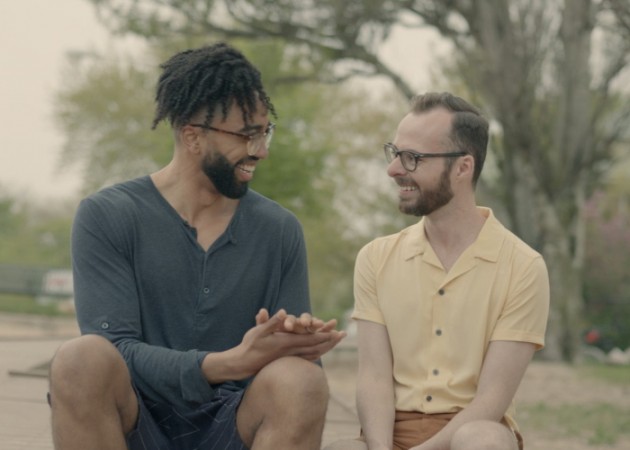
Rendezvous in Chicago: Rashaad Hall and Matt Sherbach
Offscreen: The first obvious question is how on Earth did you get Haydée Politoff, who played the title role in Eric Rohmer’s La collectionneuse, to appear in your film?
MGS: The schedule for shooting the film was set from May 16-22 of 2018. I got an email from the Film Studies Center at the University of Chicago in early April informing me that Haydée would be coming to town to do a Q&A following a screening of La collectionneuse on May 5 and they wanted to know if I was interested in interviewing her since I sometimes write film criticism. I said yes, of course, and then asked them if it would be okay if I asked her to make a cameo in my new film. They told me to go for it and I did. Haydée could not have been any nicer about doing it. She hadn’t appeared in a movie since 1981! She had gotten married, had a child and basically retired early. Anyway, I interviewed her for about 30 minutes before we shot the scene and she told me some great stories about Rohmer. I knew that she had a co-writing credit on La collectionneuse, but I assumed that was only because the dialogue had been improvised. But no, she told me that not only was the whole thing scripted, he actually asked her to help him write it long before he asked her to play the lead role. That blew my mind. They stayed friends for the rest of his life. Every time she visited Paris until he died in 2010, she would go have tea with him in his office. He was obviously the kind of director who inspired a lot of loyalty in the actors who worked for him.
Offscreen: Why start the film with the scene between her and Clare Cooney?
MGS: Originally, that scene wasn’t in the script at all. It was only after I thought to ask Haydée to do a cameo that I thought maybe she could play a faculty advisor to Delaney, Clare’s character. Then I realized that would be the best way to open the film, as a kind of pre-credits prologue. Delaney tells Paul in the wine bar that she has no time to talk to him because she’s busy working on her dissertation. If you didn’t have that opening scene at the University of Chicago, you wouldn’t necessarily believe Delaney when she says that to Paul. You might think she’s just giving him the brush-off. But Haydée says that Delaney has “a tendency to procrastinate” and that she has to defend her dissertation “before the year is over.” So now you know that not only is Delaney telling the truth, but also her doing this work is a time-sensitive matter. I think that adding that opening scene in a way makes Delaney the main character of that vignette. If not for that, it might have been more about Paul.
Offscreen: While Cool Apocalypse is classic cinema, and Mercury in Retrograde novelistic, this film strikes me as highly theatrical (three one-act plays). Does this make any sense to you?
MGS: I can see how they would seem like one-act plays. I thought of them more as short stories. They’re basically three short films stitched together. I normally don’t like the short film format because you don’t really have much time to develop the characters. So the idea with Rendezvous was to take three basic situations that felt almost like clichés (a man approaching a woman for her phone number at a bar, a marriage proposal, a woman finding her boyfriend in bed with another woman) and try to put an original spin on them. I’ve just made a 60-second film while in quarantine and that was even harder! I realized that if you only have one minute to make a film, all you can really do is tell a joke. You have 50 seconds to set up the joke and 10 seconds to execute the punch line.
Offscreen: Kevin Wehby, who played the character in Mercury in Retrograde least likely to have written the novel Mercury in Retrograde (if you follow), is discovered in this film writing the novel Mercury in Retrograde. What’s going on?
MGS: Ha! Well, his name in both Cool Apocalypse and Rendezvous in Chicago is Paul. His name in Mercury is Richard. So it’s possible that he’s the same guy in the first and third films. Maybe in the third film he’s writing a novel in which he’s projecting himself into this dark, alter-ego character named Richard.
Offscreen: Actually, Wehby’s character in Rendezvous seems to be halfway between the parts he played in Cool Apocalypse (likeable and straightforward romantic) and Mercury in Retrograde (immersed in guy stuff and clueless about how to make a relationship work). He’s a bit of a jerk here, but also with a certain amount of self-awareness.
MGS: That was 100% intentional. Kevin is an exceedingly nice and polite person in real life, a true “southern gentleman.” He’s more or less playing himself in Cool Apocalypse. But I knew he had great range as an actor and I thought if I was going to work with him again that it would be more interesting for both of us if he did the opposite of what he had done the first time around. I think he’s very convincing as an asshole in Mercury, albeit a somewhat comedic one. With Rendezvous, we decided to kind of split the difference between those two performances.
Offscreen: Two key lines in Rendezvous are “The point of the game is to look” and “I’ve always found voyeurism a little sexy.”
MGS: I decided early on that voyeurism would be a theme that would run through all three of the stories. I think voyeurism and urban living go hand in hand. When you live in the city, people are constantly surrounding you, and a lot of the time you’re not even aware of who’s looking at you. Conversely, other people aren’t always aware that you’re looking at them. That’s why we had the dialogue in the second story about cats looking out at the world through the window as if it were a television show. Anyway, I’m interested in those awkward moments where you might be in a public space, look up from what you’re doing and notice that you’re being watched. In a moment like this, the person who’s watching usually looks away in embarrassment. Even if they’re intention isn’t lecherous, they’re embarrassed because we’re taught that it’s rude to stare. I thought it would be sexy as well as tense for Delaney to kind of reverse this dynamic and say, “You can look wherever you want.” That actually makes Paul more uncomfortable.
Offscreen: To go along with the frequent references to the act of looking in all three segments, you once again go with distinct visual styles for each segment: the warm colours and frequent use of shot/reverse shot for the extended flirting in the first part, the extended backward tracking shot and use of exteriors and natural light in part two, and the long take/roving hand held camera of part three. Can you talk about how each style was chosen for its section of the film?
MGS: Yeah, the visual style was dictated by what was happening in each of the stories. I’ve never used shot/reverse shot editing before because I think it’s usually done in a really lazy way. Filmmakers will just shoot a whole scene from one angle then flip the set-up around and shoot the whole scene from the opposite angle. It removes creativity and ends up making a scene feel generic, like a soap opera. But I felt like the first segment of Rendezvous really cried out for shot/reverse shot editing because it’s two characters sitting across from each other and I wanted the dialogue to have a fast-paced, near-screwball energy. The camera is mounted on a tripod for literally every shot in that scene. In the second story, the characters know each other quite well and are going for a neighbourhood stroll, but they’re in no hurry. I wanted the camera to be handheld and mostly be in front of them. I wanted it to feel like the camera was gently pulling them towards the lake and, ultimately, their destiny. The beginning of the third story, where Nina Ganet says “Motherfucker!” and literally slaps the camera, was inspired by the beginning of Sam Fuller’s The Naked Kiss (1964). We then went crazy with the handheld camera to try and match the frenzied emotions of the characters. After she smokes weed and calms down, we switched to the static/long-take approach. As you note, there was also a different colour scheme for each vignette: reddish and warm for the first part, leafy green for the second, and cool and blue for the third. This was mostly achieved through production design choices.
_and_Kevin_Wehby_(Paul)_play_Literary_Strip_Poker_630_452_90.jpg)
Rendezvous in Chicago: Clare Cooney (Delaney) and Kevin Wehby (Paul) play Literary Strip Poker
Offscreen: The couple in part two actually talk about how great it is to live in Chicago. Is it fair to call this film, even more than your previous two films, a love letter to your adopted home town?
MGS: Yeah, when Rashaad Hall talks about how Chicago is the best city in the U.S. and how Lake Michigan “defines the city,” that’s basically me talking about how I feel. Then Matt Sherbach literally quotes “Lake Shore Drive,” the song from Cool Apocalypse: “It starts up north from Hollywood, water on the driving side / Concrete mountains rearing up, throwing shadows just about five.” I think the way the camera does a 180-degree pan away from those characters and towards the lake at the end of the scene is the most romantic moment in any of my films.
Offscreen: Is Wyatt in this film the same Wyatt as Mercury in Retrograde, or just Shane Simmons playing two different guys named Wyatt?
MGS: In my mind he’s the same guy. Just like Nina Ganet is Julie, the same character from Cool Apocalypse. She’s even wearing hospital scrubs like she did in the first film. But I don’t think it’s necessary to have seen either of the first two films to appreciate Rendezvous in Chicago.
Offscreen: Your boldest stylistic choice is part three, with Nina Ganet not only addressing the camera, but dancing with it. Why did you want to tell your story this way?
MGS: This was actually the first idea I had for the movie. Sometime in 2014, I remember thinking to myself, “I’m always falling in love with characters in movies. Why don’t they ever fall in love with me? Why is it always a one-sided relationship?” Then I asked myself, “Well, what would it look like if a character in a movie actually did start to flirt with the viewer of the movie? How exactly could that happen?” It flowed logically from that.
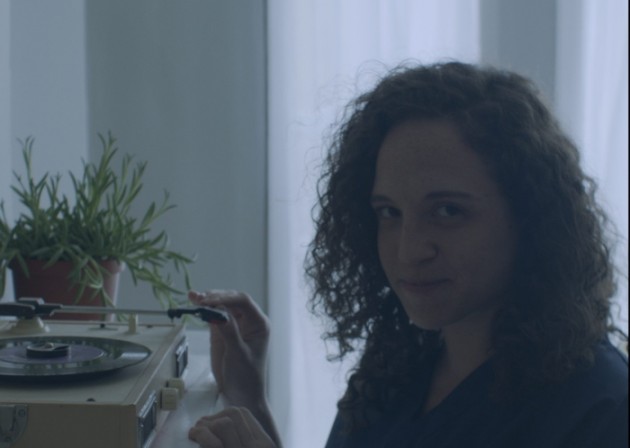
Rendezvous in Chicago: Nina Ganet
Other stuff
Offscreen: What are the economics of independent filmmaking? Is it possible to make money? How do you finance your films? What strategies do you use to get your films in front of audiences? How would an interested reader be able to see your films?
MGS: My films have been financed a number of ways. Cool Apocalypse was done via crowd funding, mostly through small donations. Mercury in Retrograde had a much higher budget, which was raised through just a few equity investors. Rendezvous was somewhere in between and was done via a combination of crowd funding and one investor. I think the biggest struggle of being an independent filmmaker today isn’t making movies; it’s getting your work seen once you’re done. With digital technology, everybody is making movies. Literally tens of thousands of films get made every year. It can be very hard to cut through all the noise.
I was lucky that Cool Apocalypse was programmed by Barbara Scharres and Marty Rubin of the Gene Siskel Film Center in Chicago. They took a chance on me and gave me two showings. In doing so, I feel like they basically discovered me and put me on the map as a filmmaker because those screenings led to positive reviews from some critics for whom I have a lot of respect (namely Ray Pride and Craig Keller). That gave me the confidence that I should try to make another movie on a bigger scale. The funny thing about Mercury in Retrograde though, is that in spite of Roxane’s presence and the high production values, it didn’t do particularly well on the festival circuit. It only played four festivals total, which was a crushing disappointment for me personally. But I think my producing partners and I did something smart. We didn’t dump the film online right away like so many filmmakers do. We submitted it to programmers of indie theaters across the country and we kept it in theaters for two-plus years. We screened a lot in Chicago and we ended up playing Spectacle Theater in Brooklyn and Rooftop Cinema Club in L.A. And those screenings were well-attended, so it ended up being a great experience. We found ways to get the film seen, but we had to be a little creative. Rendezvous, to my surprise, has been my most widely screened film to date. It played theatrically in nine states in the span of a year. That was a combination of festival screenings and being programmed by indie theaters.
Cool Apocalypse and Mercury in Retrograde have both been released on physical media by a company called Emphasis Entertainment. We also just made Mercury available to stream via Amazon and Vimeo on Demand. Rendezvous is a streaming-only release via Cow Lamp Films and you can watch it on Amazon Prime or Tubi TV. So all of these films have generated revenue in various ways, but nowhere near enough for me to make a living on. I have to teach in order to pay my mortgage and I basically make films when I’m on break in between semesters.
Offscreen: You have written a book about early Chicago cinema. Do you see yourself as part of a tradition of Chicago filmmaking? If so, are there any films from this tradition that have influenced you?
MGS: My favourite Chicago movie of all time is Medium Cool (1969). Haskell Wexler captured lightning in a bottle by shooting the 1968 Democratic National Convention here. He’s not a Chicagoan but he did his research and even hired Studs Terkel as a consultant. I think Cooley High (1975, Michael Schultz), Michael Mann’s Thief (1982), and even The Blues Brothers (1980, John Landis) all use Chicago locations very effectively. The best Chicago films of more recent years are, in my opinion, all microbudget affairs: Melika Bass makes mind-blazing experimental films that transplant a kind of Southern Gothic sensibility to the Midwest and keep Chicago weird. Jennifer Reeder, who made Knives and Skin (2019), does a fantastic job of repping Midwestern filmmaking to the rest of the world. She and her DP, Chris Rejano, are alchemists of colour and light. And I think Emily Lape’s Mercy’s Girl (2018) is a real masterpiece of blue collar Chicago portraiture that deserves to be far better known.
Offscreen: Can you talk more about Chicago’s film scene? Is it an actual scene where filmmakers know each other and work on each other’s projects? Other than your own work and the films you’ve already mentioned, what recent Chicago films would you recommend checking out?
MGS: For the most part, Chicago filmmakers know each other pretty well. The scene has definitely gotten bigger in recent years and a lot of us will joke that we’re on the verge of a “Chicago New Wave.” There are so many great indie films being made here. Frank V. Ross, who edited Mercury in Retrograde, was one of the key directors of the original Mumblecore movement. He makes beautiful character studies about working class people in the suburbs. His 2010 film Audrey the Trainwreck is one of my favourites. Eric Marsh, who edited Rendezvous, is likewise a terrific writer-director in his own right. He made a great absurdist war movie called Orders (2017) that you can stream for free on Kentucker Audley’s site NoBudge (http://nobudge.com/ ). My buddy Rob Christopher just made an excellent documentary, Roy’s World (which, full disclosure, I helped produce), about the writer Barry Gifford’s childhood in Chicago. It consists almost entirely of archival footage of Chicago from the ‘40s and ‘50s, plus a couple of animated sequences, and it’s narrated by Willem Dafoe, Matt Dillon and Lili Taylor. The film had its World Premiere at the Glasgow Film Festival right before COVID-19 exploded. It had a great response there, so we’re looking forward to resuming the festival run as soon as life goes back to normal.
Offscreen: Can you talk about your current project?
MGS: My next film, which I just finished shooting, is titled RELATIVE and it’s about a family get-together on the north side of Chicago. It’s another character driven piece, but it will be different from my earlier films in that it will be more about parent-child relationships. It’s sort of my version of an Ozu film. It stars the great Wendy Robie, who is best known for playing Nadine Hurley on TWIN PEAKS. She’s fantastic in it and I think it will be my best film. We were originally supposed to shoot in May of 2020, but production had to be pushed a full 13 months because of the pandemic. It will most likely have a World Premiere at a festival early next year.
Trailers:
Cool Apocalypse: https://www.youtube.com/watch?v=OuzpS7IfUcU”:https://www.youtube.com/watch?v=OuzpS7IfUcU”:https://www.youtube.com/watch?v=OuzpS7IfUcU
Mercury in Retrograde: https://vimeo.com/334706775
“:https://vimeo.com/334706775”:https://vimeo.com/334706775
Rendezvous in Chicago: “https://www.youtube.com/watch?v=eRz_Up1m8V0

